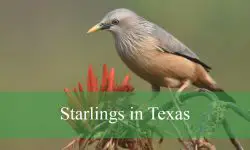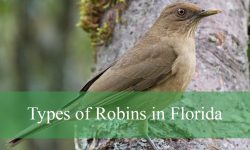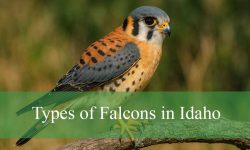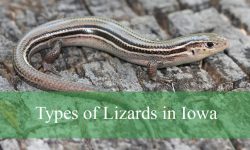There’s something magical about the flutter of tiny wings and the flash of iridescent feathers that draws us to hummingbirds. In Kansas, these jewel-like visitors bring life and color to gardens, meadows, and woodlands, especially during migration seasons.
While only one species is commonly seen throughout the state, several rare and unexpected guests have also made appearances. From the familiar Ruby-throated to the occasional Broad-billed, each hummingbird offers a unique glimpse into nature’s artistry.
In this guide, you’ll meet 10 types of hummingbirds recorded in Kansas, complete with pictures and identification tips. Whether you’re a backyard birdwatcher or a curious nature lover, there’s always something new to discover in the sky above.
Common Hummingbirds Found in Kansas
Ruby-throated Hummingbird (Archilochus colubris)
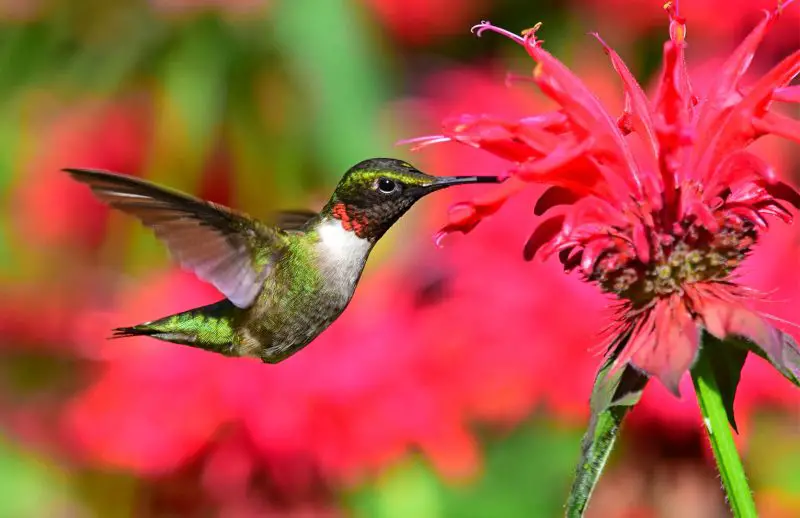
The Ruby-throated Hummingbird is the most common and widespread hummingbird in Kansas, especially in the eastern parts of the state during the spring and summer months. Males are easily recognized by their iridescent ruby-red throat patch (gorget), which can appear black in certain lighting. Both sexes have bright green backs, white underparts, and slender black bills that are slightly downcurved.
This species measures about 3 to 3.5 inches long with a wingspan of 3.1 to 4.3 inches. They are lightweight, weighing only around 2 to 6 grams. Their wings beat rapidly—about 50 times per second—allowing them to hover and maneuver mid-air with incredible precision.
In Kansas, Ruby-throated Hummingbirds are most active from late April through September, favoring gardens, woodlands, meadows, and areas with flowering plants. They feed primarily on nectar from native wildflowers and garden blooms, but also consume small insects and spiders for protein. They often visit feeders filled with sugar water during migration.
Fun Fact: During migration, some Ruby-throated Hummingbirds fly nonstop over the Gulf of Mexico, covering more than 500 miles in a single 18–22 hour flight!
Rufous Hummingbird (Selasphorus rufus)
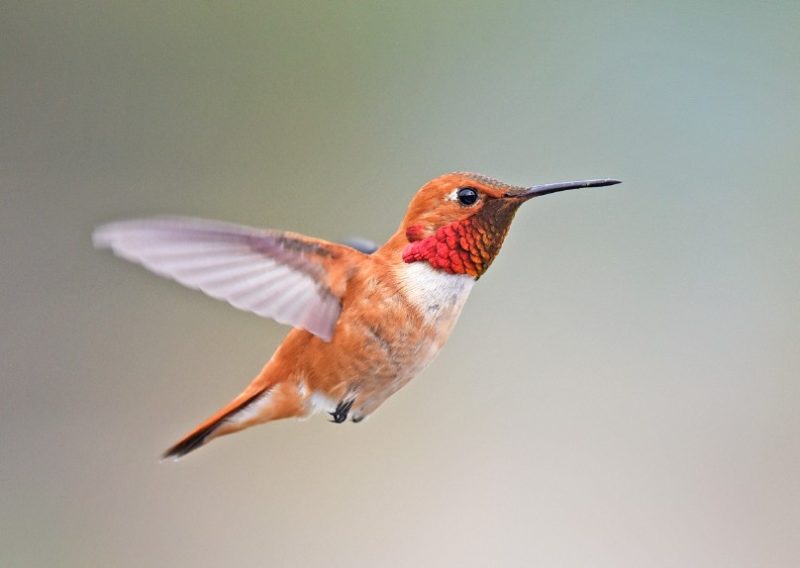
The Rufous Hummingbird is a rare but regular migrant through Kansas, especially noticeable during late summer and early fall. Males are striking with a fiery orange back, rufous-colored sides, and a shimmering red-orange throat. Females are more subdued, with green backs, rufous flanks, and spotted throats.
These hummingbirds are slightly smaller than Ruby-throateds, measuring around 2.8 to 3.5 inches long with a wingspan of about 4.3 inches. Despite their tiny size, they’re known for their aggressive nature, frequently chasing other hummingbirds away from feeders or favorite flowers.
Rufous Hummingbirds prefer open habitats such as forest edges, yards, and fields with scattered shrubs. In Kansas, they are usually spotted in late July through October during southbound migration. They feed heavily on nectar, often defending food sources with bold aerial displays, and will also eat small insects.
Fun Fact: Rufous Hummingbirds hold the record for the longest migration relative to body size of any bird in the world—up to 4,000 miles between Alaska and Mexico!
Black-chinned Hummingbird (Archilochus alexandri)
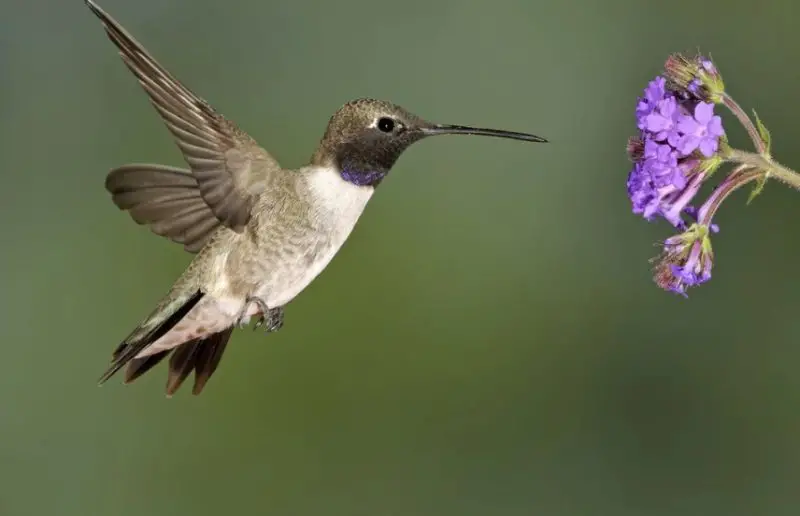
The Black-chinned Hummingbird is an uncommon visitor in Kansas, primarily seen during migration in the western and central parts of the state. Males have a distinctive black throat with a narrow band of iridescent purple at the base, though this may only be visible under direct light. Females lack the dark throat and have a plainer appearance with green backs and whitish underparts.
They measure about 3.25 inches in length and weigh approximately 2.9 grams. Their wings produce a low, insect-like hum as they hover. Black-chinned Hummingbirds are known for their ability to adapt to a variety of habitats, including arid regions, riparian corridors, and urban gardens.
In Kansas, they are most likely to be seen during spring and fall migrations, typically from May to early June and again from late August through September. They forage on nectar from tubular flowers and often catch tiny insects midair or pick them from foliage.
Fun Fact: When diving during courtship, Black-chinned Hummingbirds reach speeds that produce a unique buzzing sound caused by air passing over their tail feathers!
Broad-tailed Hummingbird (Selasphorus platycercus)
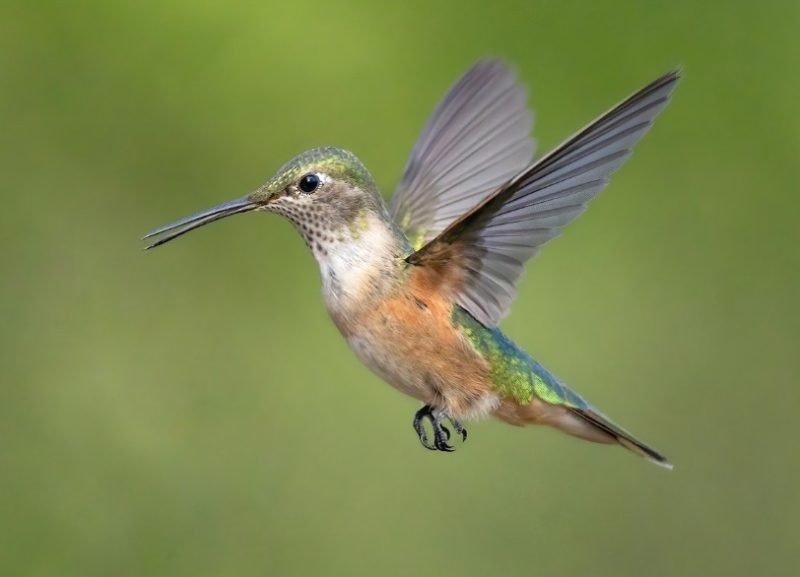
Broad-tailed Hummingbirds are rare visitors to Kansas, more likely spotted in the western part of the state during migration. Males are recognized by their metallic rose-colored throats, while both sexes display bronze-green backs and rounded tails with broad feathers, giving them their name.
They are medium-sized for hummingbirds, about 3.75 inches long with a wingspan of around 5.25 inches. Their wingbeats are slower than those of other hummingbirds, creating a distinct trilling sound that is often heard before the bird is seen.
Broad-tailed Hummingbirds prefer montane meadows and open woodlands at higher elevations, though they pass through Kansas in late spring or early fall. They visit flowers and feeders and rely heavily on nectar, supplementing with flying insects when available.
Fun Fact: These hummingbirds can enter a torpid state overnight, dramatically slowing their metabolism to conserve energy in colder temperatures—a trait especially useful at high elevations.
Calliope Hummingbird (Selasphorus calliope)
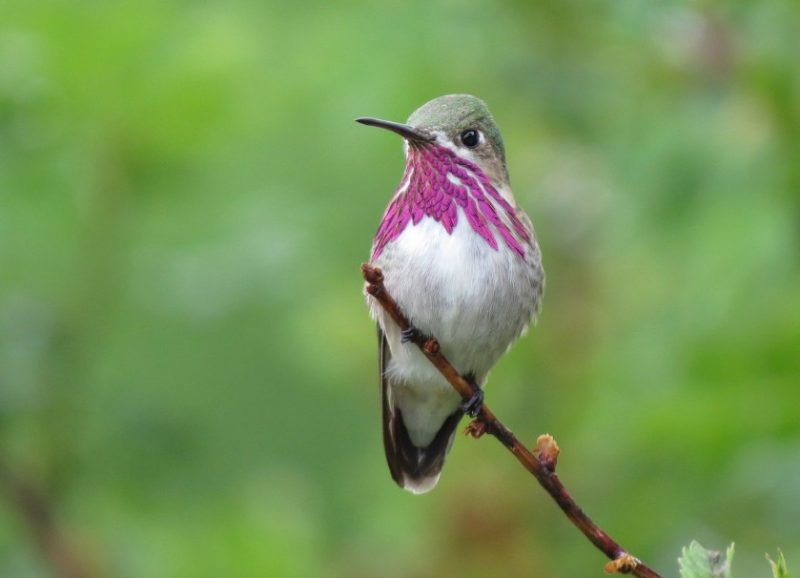
Calliope Hummingbirds are the smallest hummingbirds in North America and are extremely rare in Kansas. Males are distinct with vibrant magenta streaks that radiate from the throat, while females and juveniles have white underparts with greenish upperparts and subtle markings.
This tiny bird measures only 2.75 to 3.25 inches in length and weighs about 2.5 grams—about the weight of a ping-pong ball. Despite its size, it’s known for long migrations and unexpected appearances in unusual locations like Kansas.
In the state, Calliope Hummingbirds are typically spotted during migration, often in late summer or early fall. They visit flowering plants and hummingbird feeders, seeking nectar, and will occasionally catch small insects. They’re most likely seen in backyard gardens or open woodland edges.
Fun Fact: Even though it’s the smallest bird in the U.S., the Calliope Hummingbird defends its territory fiercely and will often chase away much larger hummingbirds or even small songbirds!
Anna’s Hummingbird (Calypte anna)
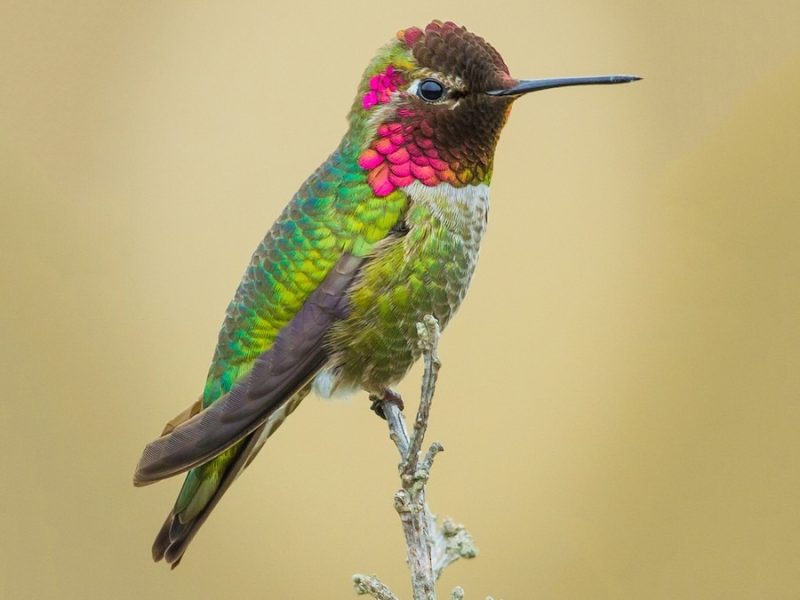
Anna’s Hummingbird is a rare and irregular visitor in Kansas, more commonly found along the Pacific Coast. Males are stunning, with iridescent rose-pink throats and crowns that glow vividly in the sunlight. Females lack the full crown color but often show a patch of pink on the throat, with green backs and pale gray underparts.
This species measures about 3.9 to 4.3 inches long and weighs between 3 to 6 grams. Slightly larger than other Kansas hummingbirds, Anna’s Hummingbirds are known for their acrobatic flight displays and high-pitched vocalizations, which are uncommon among hummingbirds.
Anna’s Hummingbirds are typically non-migratory in their home range but may wander eastward during fall and winter. In Kansas, they are rare and usually appear in late autumn or winter months near backyard feeders. They consume nectar, tree sap, and small insects, thriving in urban gardens or wooded areas with flowering plants.
Fun Fact: Unlike most hummingbirds, Anna’s Hummingbirds can sing—a series of scratchy, metallic notes used in courtship and territory defense!
Broad-billed Hummingbird (Cynanthus latirostris)
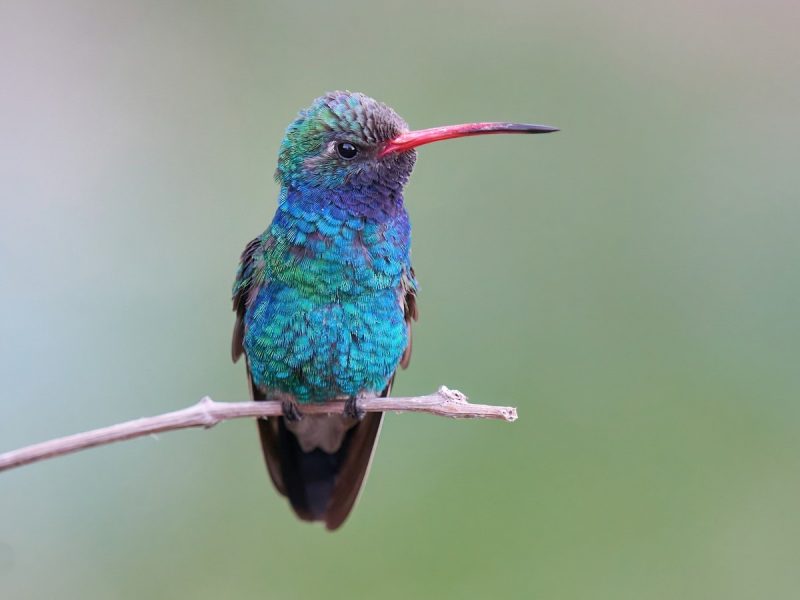
The Broad-billed Hummingbird is a striking and rare visitor to Kansas, typically appearing only as an accidental vagrant. Males are vivid green with a brilliant blue throat and a bold red bill tipped in black. Females are duller, with a plain green back and a slightly curved red-based bill.
They are about 3.5 to 4 inches long with a wingspan around 5 inches. Their distinctive broad and brightly colored bill sets them apart from other hummingbirds, and their overall structure appears stockier.
Broad-billed Hummingbirds are native to the southwestern U.S. and Mexico but have occasionally been recorded in Kansas, often during late summer or fall. They are usually found in riparian areas, deserts, and gardens with tubular flowers, where they forage for nectar and flying insects.
Fun Fact: The male Broad-billed Hummingbird performs a dramatic courtship display, flying in a wide U-shaped arc in front of the female while emitting a mechanical-sounding trill with his wings.
Costa’s Hummingbird (Calypte costae)
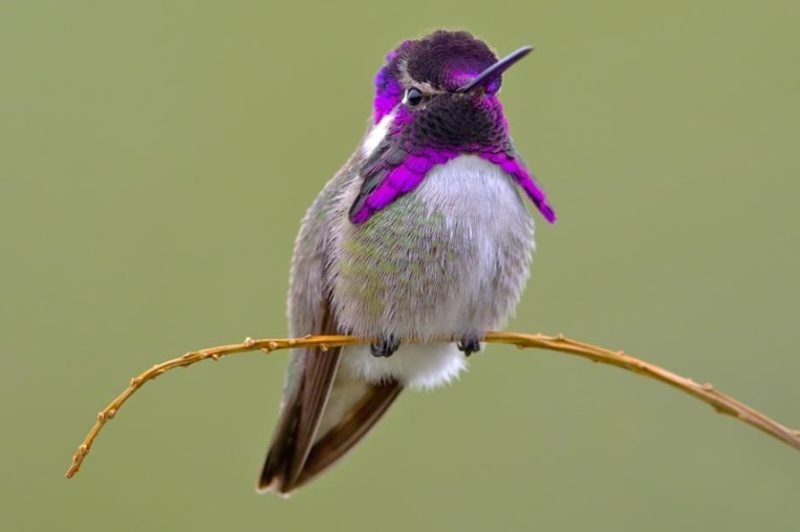
Costa’s Hummingbird is an exceptionally rare species in Kansas, far outside its typical desert habitat in the southwestern United States. Males are eye-catching with deep violet-purple crowns and throats that flare out at the sides. Females are plainer, with green backs and whitish underparts.
This species is small, around 3 to 3.5 inches long, weighing about 2 to 3 grams. Males have a unique appearance with short, slightly decurved bills and elegant flared gorgets that give them a regal look.
In Kansas, Costa’s Hummingbirds are recorded as rare vagrants, usually seen in late summer or fall near feeders. They feed on nectar from desert flowers in their home range but are adaptable and will visit backyard feeders and gardens during their unexpected travels.
Fun Fact: The male Costa’s Hummingbird performs a high-speed dive display that produces a high-pitched sound created by wind passing through his tail feathers—part of his dramatic courtship ritual.
Mexican Violetear (Colibri thalassinus)
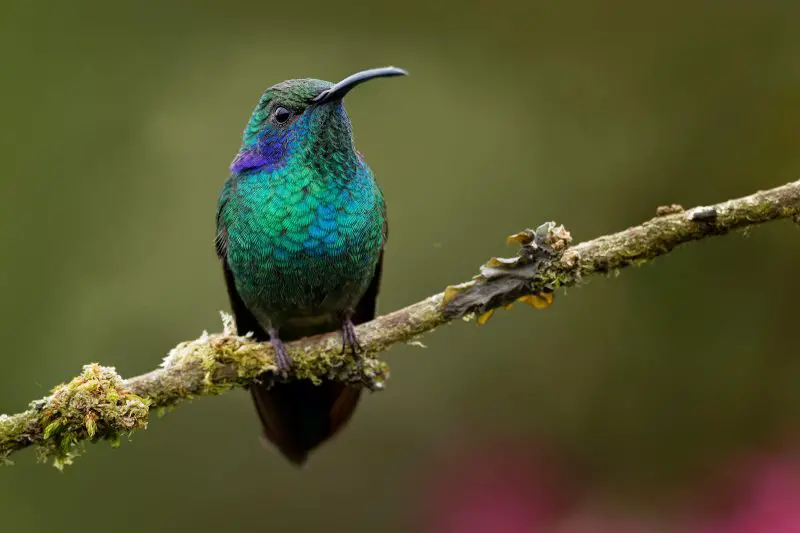
The Mexican Violetear is a rare and exotic-looking hummingbird that occasionally strays into Kansas from its native range in Mexico and Central America. It is medium-sized and brilliantly colored, with shimmering green plumage and violet patches on the sides of the head and chest.
This species is larger than most Kansas hummingbirds, measuring about 4.5 to 5 inches long and weighing around 5 to 6 grams. It has a slightly notched tail and a straight, dark bill. The violet “ear” patches are particularly striking and give the species its name.
In Kansas, sightings are sporadic and usually involve individual birds appearing at feeders during the warmer months. Their preferred habitat includes humid forests and tropical highlands, but they adapt well to gardens and wooded suburban areas while migrating.
Fun Fact: The Mexican Violetear is known for its loud, repetitive song—a series of metallic “tsip” notes that are often sung from a hidden perch in the forest.
Rivoli’s Hummingbird (Eugenes fulgens)
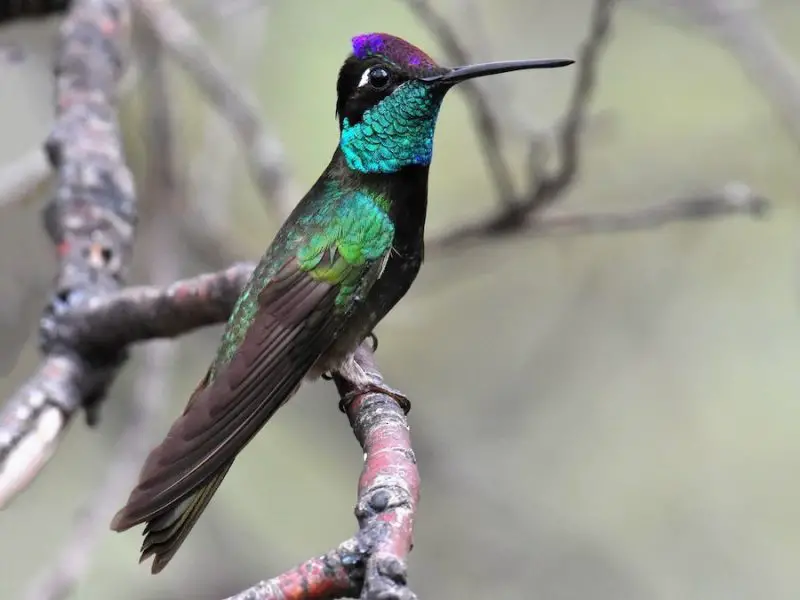
Rivoli’s Hummingbird, also known as the Magnificent Hummingbird, is an uncommon vagrant in Kansas, more typically found in the mountainous forests of the southwestern U.S. and Mexico. Males are dazzling, with iridescent emerald green backs and violet crowns and throats. Females are mostly green with grayish undersides.
This is one of the largest hummingbirds found in the U.S., measuring around 5 to 5.5 inches in length and weighing up to 10 grams. Its size and colorful, shimmering plumage make it stand out among smaller, more common hummingbird species.
In Kansas, Rivoli’s Hummingbird is extremely rare and has only been observed on a few occasions, usually at hummingbird feeders. They favor pine-oak forests and high mountain canyons but are known to stray far from their typical habitat during migration or post-breeding dispersal.
Fun Fact: Despite their large size, Rivoli’s Hummingbirds are strong fliers and capable of hovering just as gracefully as their smaller relatives—earning them the name “magnificent” for both size and beauty.
FAQs About Hummingbirds in Kansas
How many types of hummingbirds are found in Kansas?
There are 10 species of hummingbirds that have been recorded in Kansas. Of these, only the Ruby-throated Hummingbird is commonly seen and breeds in the state. The other nine species are considered rare or accidental visitors.
When do hummingbirds arrive in Kansas?
Most hummingbirds arrive in Kansas in late April to early May during spring migration. Ruby-throated Hummingbirds are typically the first to appear and are most numerous throughout the summer months.
When do hummingbirds leave Kansas?
Hummingbirds generally begin their southward migration in late August through September. By early October, most hummingbirds have left the state to spend winter in warmer climates like Central America or the southern U.S.
What is the most common hummingbird in Kansas?
The most common and widespread species is the Ruby-throated Hummingbird (Archilochus colubris). It is the only species known to nest and breed regularly in Kansas and is frequently seen at backyard feeders.
Do hummingbirds live in Kansas year-round?
No, hummingbirds do not stay in Kansas all year. They are migratory birds, and most only remain in the state during the warmer months, typically from late April to early October.
What should I put in a hummingbird feeder in Kansas?
You should fill your feeder with a sugar-water solution made of 1 part white granulated sugar to 4 parts water. Do not add red dye, as it can be harmful to hummingbirds. Clean feeders every 2–3 days in hot weather.
Where is the best place to see hummingbirds in Kansas?
Hummingbirds can be found in gardens, woodlands, meadows, and parks across the state, especially in areas with plenty of nectar-rich flowers. Eastern Kansas tends to have more frequent sightings due to the Ruby-throated Hummingbird’s preference for that region.
What flowers attract hummingbirds in Kansas?
Hummingbirds are especially attracted to tubular flowers like trumpet vine, bee balm, salvia, columbine, cardinal flower, and coral honeysuckle. Bright red and orange blooms are particularly appealing to them.
Can rare hummingbirds show up at Kansas feeders?
Yes, rare species such as Rufous, Broad-tailed, or even Mexican Violetear have been observed at backyard feeders in Kansas. These sightings usually occur during migration or as a result of unusual weather patterns.
Why do hummingbirds fight at feeders?
Hummingbirds are territorial and often aggressive when defending a food source. Males, in particular, will chase away others to control access to nectar. Providing multiple feeders in different locations can help reduce conflict.

